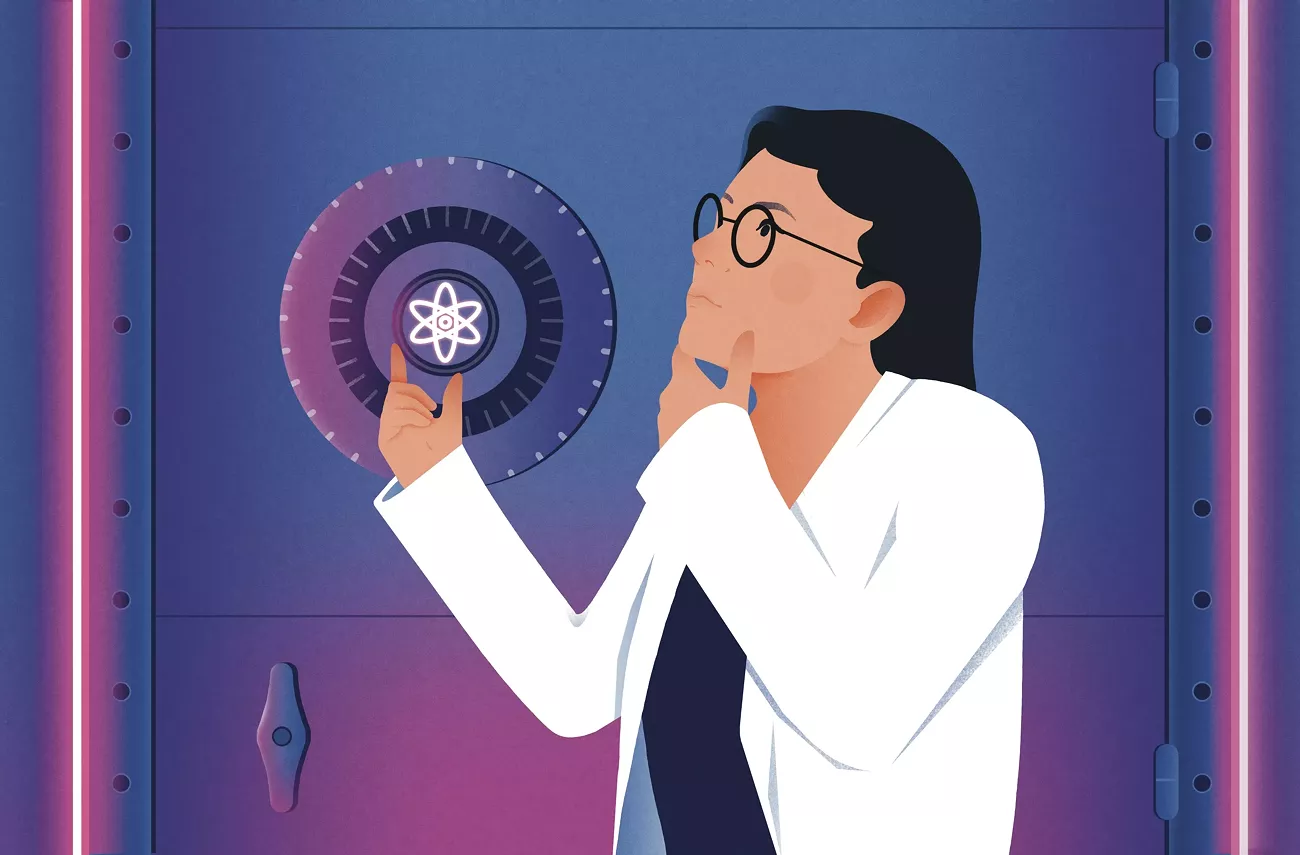The word “nuclear” conjures two images: A family and a mushroom cloud. Or for some, two trumpeting columns coughing clouds over Springfield, Homer Simpson unaware of the glowing green rod that’s slipped into his jumpsuit. It does not conjure whatever the hell I was looking at in the basement of the Aerospace & Engineering Research Building at University of Washington: A Frankenstein’s Monster of telescope, cannon, and submarine.
There was a six-foot cylinder at the center of the room, held up by what looked like two sturdy metal sawhorses, gleaming in the fluorescent light like a new sheet of tinfoil. Portholes of dark glass with jutting rivets lined the side. On top, brackets secured a smaller, thinner metal tube at a 45-degree angle. My tour guides, two PhD students using the device, call it the “Z-pinch,” a name that doesn’t clear things up on its own.
The object in the middle of the room was a nuclear device for scientists to study nuclear fusion. It’s unrecognizable, perhaps, because most of our “nuclear” images stem from the nuclear fission—associated with power plants and atom bombs. But someday, fusion could power the Earth and take us to the stars.
Unlike fission, fusion doesn’t create gobs of radioactive waste for us to store for thousands of years. Fission is a chain reaction that can spiral out of control; but fusion reactors don’t melt down; they stop when the power is cut. Fusion also doesn’t require us to mine for rare, highly radioactive materials like uranium or plutonium. Water and lithium contain almost all that’s needed. Not only that, fusion has a higher energy yield than fission. It wouldn’t contribute to the greenhouse effect like oil and gas or depend on sunny weather like solar panels (and outside of a very freaky situation, birds aren’t likely to smack into a fusion reaction).
The problem is, we haven’t quite cracked fusion power yet.
Scientists know it’s possible and carries the potential for near-limitless amounts of clean energy. It would change our world forever, perhaps staving off resource wars and humanity’s final conclusion, choking on a puff of hydrocarbonic smog in a room with the thermostat turned all the way up. If fossil fuels are our fatal attraction, fusion could be our salvation.
The door to Professor Bhuvana Srinivasan’s office in the aerospace building is open. A bike helmet rests on a filing cabinet in the corner, and through a thin layer of dust, dappled underbrush peeks between towering trunks of a pine forest on her curved desktop monitor. The brightness is set to low, and the lights are off. She hovers by the light switch as I sit down and asks if I’d prefer them on. Through a window, bright sunlight washes the walls, a result of the fusion reactions she studies as a professor of Aeronautics & Astronautics.
Everything comes from fusion, she says. People like to say the sun is like a nuclear bomb perpetually exploding above us, but that’s not right. At its core lies something akin to a giant fusion reactor. Fusion is a nuclear process, but in this context, Srinivasan calls it fusion power. “Nuclear” comes with a lot of baggage (not to knock fission, she says, which has gotten better and cleaner over time).
At the most basic level, fission deals with splitting atoms, while fusion is about combining them. We accomplish fission by taking the heaviest, largest, unstable atoms we can find and firing neutrons—particles that don’t have an electric charge—at their nuclei until they split, triggering a chain reaction with other atoms. We can harness this energy to power our homes or blow up someone else’s. (For some perspective, the first atomic bomb used 141 pounds of refined uranium. Only three pounds underwent fission to destroy Hiroshima with a halo of flame.)
The discovery of fission in late 1938 revolutionized nuclear physics. By 1945, when the US dropped its bombs, it was also a confirmation of everything we knew about human nature. (By 1952, we’d harnessed fusion for destruction in the form of the H-bomb.)
The first theory of fusion emerged in 1926, when British astrophysicist Arthur Eddington published The Internal Constitution of the Stars, his theory that fusion powers our sun—and all other suns, for that matter. He was right, and other physicists ferreted out the specifics over the next decade. In 1934, physicists Ernest Rutherford, Mark Oliphant, and Paul Harteck discovered that bombarding deuterium with deuterons (the nucleus of deuterium) released a tremendous font of energy, the first fusion reaction in the lab.
We’ve been figuring out how to generate electricity from the reaction ever since. In the 1950s, Soviet scientists Andrei Sakharov and Igor Tamm designed the tokamak, the first attempt at confining plasma, a super-hot ionized gas, with magnets long enough for fusion to occur. In 1951, American Lyman Spitzer conceived the stellarator, another magnetic confinement device with a more complex magnetic topography, reflected by its asymmetrical design, like a twisted rubber band inside a Slinky. In the 1980s, two University of Utah chemists by the name of Stanley Pons and Martin Fleischmann told the world they’d achieved fusion at room temperature, so-called “cold fusion,” but this was more science fiction than science fact, like the time Doc Brown used kitchen scraps to power the time-traveling DeLorean in Back to the Future II. (Pons and Fleischmann never retracted their claims, but they could never reproduce them. Our understanding of physics doesn’t even support the possibility of cold fusion.)
Scientists around the world are trying to unlock the key to sustained fusion reactions that reliably generate more power than they take to initiate.
An important first step to getting a reaction to sustain itself without having to add more power, called ignition, was done for the first time in December 2022, when researchers at Lawrence Livermore National Laboratory’s (LLNL) National Ignition Facility (NIF) near San Francisco fired 192 lasers at a pellet the size of a peppercorn, a diamond containing frozen deuterium and tritium, two heavier forms of hydrogen, separated by gold. When hit by the lasers, the gold begins to emit X-rays. These rays shine through the capsule, which heats to a temperature hotter than the core of the sun. The capsule’s outer layer of carbon almost explodes, but the counterforce of the X-rays causes it to implode. In this thermonuclear reaction, the deuterium and tritium fuse, releasing energy and helium just like the sun. This process of using lasers to rapidly heat and compress a capsule is called inertial confinement. It all happens in a flash, lasting tens of nanoseconds.
As Livermore had been lighting up these little spheres since 1997, it was a breakthrough so astounding and monumental that one scientist burst into joyful tears, according to The New York Times. The Secretary of Energy at the time called it one of the most impressive scientific feats of the century. In July 2023, they did it again, releasing even more energy. But their work was far from over, scientists stressed. It could be decades before we’re powering our cars and coffee makers this way—longer than we may have to break our oil and gas habit before Earth goes kaput.
In her office, Professor Srinivasan ticked off a handful of the obstacles in our way. To generate the power we need, a power plant would have to expend several diamond pellets a second. We’ve yet to perfect them, which could be key. The more perfect the sphere, the more even the implosion. The more evenly the capsule implodes, the more effective the reaction. The highest-performing capsules have taken months to manufacture, which is much too long to be practical.
Our lasers aren’t fast enough, either. LLNL can only fire theirs about 10 times a day. We need powerful lasers that can fire many shots a second, a challenge because they get tremendously hot. Overdo that and you’ve got a broken laser and even more time lost.
And that’s just for inertial confinement. Another method of achieving fusion, called magnetic confinement fusion, relies on holding plasma (a state of matter where atoms are stripped of their electrons) in a state of equilibrium. In this case, it’s not speed scientists are looking for, but stability, by keeping the plasma locked in a tight “magnetic cage” long enough for fusion to occur. Left to their own devices, the super-heated atoms would ricochet off the walls of the reactor, like dollar store bouncy balls in a rubber room.
The turbulent magnetic fields are thrown easily out of whack, but they have to be unshakable. Physicists compare this to holding jelly with rubber bands. The tighter the compression, the more likely it is to erupt from the gaps. Unstable plasma won’t fuse, or may even channel a damaging beam of energy at one section of wall, paralyzing the reactor for days or weeks at a time.
It’s not that these problems are unsolvable, they’re just devilishly tough. That’s what Professor Srinivasan’s PhD student, Daniel Alex, likes about them. He studies the magnetic fields self-generated by plasma. The swim of free ions and free electrons can cause currents, electric fields, and magnetic fields.
These magnetic fields affect how those diamond capsules implode when shot through with lasers. Localized magnetic fields can cause drops in temperature, which accelerate the mixing between the hot and cold layers, and cause the overall temperature of the capsule to drop. High temperatures get us the reaction that we want. The mixing also causes a slight asymmetry in the collapse, even in a capsule engineered to be perfectly round.
But these magnetic fields are not always accounted for in simulations. It’s expensive enough to study the hydrodynamic effects without tossing three-dimensional magnetic fields on top. Filling those gaps in our knowledge could improve simulations and get scientists closer to solving at least one efficiency problem, Alex explained.
With all the recent developments, it’s an exciting time to be a scientist studying fusion power, says Srinivasan. A good deal of support for fusion comes from Department of Energy grants, and Trump’s Secretary of Energy Chris Wright, an oil guy who is for liquefied natural gas and against solar and wind power, is a proponent of fission and fusion. He studied nuclear fusion at the Massachusetts Institute of Technology, so fusion technology may be spared from the federal government’s merciless budget cuts. The same can’t be said for research institutions themselves, the “woke” target of the Trump ignorance brigade.
“I graduated 10 PhD students, and they’ve all gone on to do wonderful things—work for the Department of Energy, national labs, industry, various things that contribute to many aspects of computation, plasma physics, and fusion,” Srinivasan says. “This year, I might not hire any graduate students, because I don’t know what’s going to happen with my funding… The uncertainty alone is keeping us from maintaining a certain level of workforce development and training necessary to promote our field.”
Back by the door of the Flow Z-Pinch lab in UW’s basement—a high-ceilinged concrete room crowded with hulking electrical equipment—sits a high-speed camera that shoots 5 million frames per second.
After hopping off a flight from the East Coast, UW Professor Uri Shumlak tells me he built it in 1998. The Z-Pinch wasn’t his idea; it’s been around for decades, the result of a literal bolt from the blue. In 1905, lightning struck a hollow metal lightning rod on a kerosene refinery in New South Wales, Australia, leaving it crushed and twisted.
Scientists rightly hypothesized its gnarled appearance came not from the power of the strike but by magnetism. Scientists already knew two electrified wires carrying currents in the same direction would drift toward one another. Since a metal tube is like a circle of wire, the lightning strike caused it to “pinch” inward.
In the 1950s, scientists in the UK took this concept to the earliest fusion experiments, running a strong electric current through hydrogen gas in a Z-pinch to create a plasma. They thought they’d achieved fusion then, but the experiments were ultimately a failure. Science dropped the device in favor of the Soviet tokamak, but the famed instability of the Z-pinch is precisely what interested Shumlak. He wanted to find novel ways to stabilize it. The key turned out to be “sheared flow,” or accelerating layers of plasma at different speeds within the fusion core.
Picture a car putting along the backed-up center lane of a highway. The faster the cars in the outer lanes are moving, the harder it is for the car to merge left or right. The faster-moving outer layer of plasma stabilizes the slower-moving inner layer, holding the plasma in place long enough, theoretically, to create fusion.
In 2017, Shumlak took this theory and founded Zap Energy with Brian A. Nelson and Benj Conway. They hope to scale it to high-performance plasmas that produce more energy than they put in. They’re working on technology to capture that steady flow of energy in a liquid blanket of lithium. The energy could generate heat, boiling water into a rising stream that spins a turbine, like most power plants use.
Shumlak believes fusion is a matter of civilizational importance. As a child, working at a gas station in the 1970s, he watched cars in dizzying lines to fill up during OAPEC’s oil embargo on the United States. It struck him as ridiculous—the whole world revolving around the sludge of decayed dinosaurs. It clicked early that energy derived from resources in the ground divided the world into haves and have-nots,.
“Fusion is the democratization of energy,” he says. “If you have access to water, you have all the fusion fuel you need to power your country. It would completely change the way we think about energy.”
Private capital from billionaires Bill Gates, Jeff Bezos, Richard Branson, and Sam Altman is flowing into companies on the quest to build an artificial star. Commonwealth Fusion Systems in Massachusetts has raised more than $2 billion for its work with a souped-up tokamak, with its 30-ton magnets generating a mind-boggling magnetic force equal to 10 rockets breaking free of the Earth. In 2024, Pacific Fusion raised $1 billion. With this unprecedented investment, this could be fusion’s moment.
The Altman-backed Helion Energy promises the age of fusion power will begin in Washington State by 2028, with an operational 50-megawatt fusion power plant in Malaga to power Microsoft data centers. (Billionaires preach world-saving agendas, but they’ve been happy to sidestep climate goals for the energy monster of AI. The motivation to power the tech they plan to suffuse our lives with can’t be ignored. Even data centers are stressing our grid.) With as many barriers and scientific unknowns—even unknown unknowns—ahead, 2028 is a big promise.
The company says its sixth prototype, Trenta, achieved enough fusion for commercially viable energy production, the first privately funded device to do so. But they ripped it up and started again with Polaris, its seventh. Both employ Magneto-Inertial fusion, a combination of inertial and magnetic confinement the company says is smaller and lower cost.
Michael Hua, Helion’s director of nuclear, chemical, and materials, says the company’s nimble, darling-killing focus on new iterations will propel them to meet their goal. The first test with Trenta answered 90 percent of their questions, he says. Helion could spend three years answering the last 10 percent, but building another device was faster and cheaper, he says. They’re not just focused on climate change; it’s a business, too. Should Helion crack fusion, the company would manufacture these reactors for the world.
Science can’t be rushed, but fusion’s true believers think capturing the sun in a bottle could light humanity’s future. For our sake, I hope they figure it out. It’s getting hot in here.




















